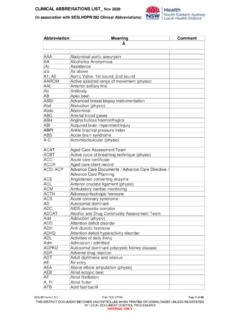Transcription of Potassium - Administration of oral and intravenous infusion
1 LOCAL OPERATING PROCEDURE CLINICAL POLICIES, PROCEDURES & GUIDELINES Approved by Quality & Patient Care Committee 7 July 2016 Potassium Administration OF ORAL AND intravenous infusion This LOP is developed to guide clinical practice at the Royal Hospital for Women. Individual patient circumstances may mean that practice diverges from this LOP. 1. AIM To ensure the safe storage, prescribing, Administration and monitoring of Potassium replacement. 2. PATIENT Women requiring Potassium replacement.
2 3. STAFF Medical officers Registered nurses and midwives Pharmacists 4. EQUIPMENT infusion pump 5. CLINICAL PRACTICE PRESCRIBING Consider commencing IV Potassium replacement only when the oral route is unavailable or will not achieve the required elevation of serum Potassium within a clinically acceptable timeframe. Repeat serum Potassium level if it is below the desired range, repeat measurements must be taken after interventions, until the serum Potassium level is corrected. Use premixed bags when possible.
3 Prescribe IV Potassium by writing Potassium (and salt) in full Potassium chloride . No chemical abbreviations are acceptable. EXAMPLE NOT Potassium chloride KCl Potassium dihydrogen phophate KH2PO4 Prescribe Potassium in millimoles (mmol), not in milligrams (mg) Never deliver IV Potassium as a bolus. All prescriptions should include an infusion rate or period of time. EXAMPLE NOT Potassium chloride 10mmol in 100mL sodium chloride IV over one hour Potassium chloride 10mmol IV stat Order all infusions on the IV fluid order chart or the High Acuity Chart as appropriate in accordance with the DOH and RHW medication Administration policy Prescribe new orders for IV Potassium daily after review of serum Potassium levels.
4 Multiple day orders will not be recognised../2 2. LOCAL OPERATING PROCEDURE CLINICAL POLICIES, PROCEDURES & GUIDELINES Approved by Quality & Patient Care Committee 7 July 2016 Potassium Administration OF ORAL AND intravenous infusion cont d Transfer the patient to Acute Care if requiring concentrations greater than 10mmol in 100mL of Potassium chloride, 10mmol in 250mL of Potassium dihydrogen phosphate or Potassium acetate or a serum Potassium level < mmol/Lfor continuous cardiac monitoring, more regular observations.
5 Frequent serum Potassium measurements and assessment of renal function. See Acute Care admission policy. Do not delay Potassium replacement while awaiting a bed in Acute Care. The patient is to have an IV cannula inserted and have oral and a Potassium infusion commenced as per the admitting Dr. AVAILABILITY AND SUPPLY The availability of Potassium ampoules in ward areas has been identified as a common root cause of errors associated with preparation and Administration of intravenous Potassium . Such errors have the potential to cause serious or catastrophic harm to patients.
6 ORAL PREPARATIONS Type mmol of Potassium Common trade names Potassium chloride slow release tablets 8mmol per tablet Slow-K, KSR, Duro-K or Span-K Potassium chloride effervescent 14mmol per tablet Chlorvescent, K Sol Potassium chloride oral mixture 20mmol per 15mL STANDARD IV Potassium SOLUTIONS Standard pre-mixed intravenous Potassium solutions MUST be used where possible. The following pre-mixed Potassium bags are available at RHW: 10mmol Potassium chloride in 100mL sodium chloride (ISOTONIC SOLUTION) 20mmol Potassium chloride in 1000mL sodium chloride 30mmol Potassium chloride in 1000mL sodium chloride 30mmol Potassium chloride in 1000mL glucose 4% + sodium chloride (DKS) Other pre-mixed Potassium solutions exist however are not routinely used at RHW.
7 Pre-mixed IV Potassium solutions are labeled in red and have a pink outer packaging. CONCENTRATED Potassium AMPOULES Only use Potassium ampoules to make an IV solution if a pre-mixed bag is not available. The availability of Potassium ampoules in ward areas has been identified as a common root cause of errors associated with preparation and Administration of intravenous Potassium . Such errors have the potential to cause serious or catastrophic harm to patients. Potassium ampoules available in RHW pharmacy: Potassium chloride 10mmol in 10mL Potassium acetate 25mmol in 5mL Potassium dihydrogen phosphate (each 10mL contains 10mmol Potassium ions, 10mmol phosphate ions and 20mmol hydrogen ions) Dipotassium hydrogen phosphate (each 10mL contains 25mmol Potassium ions, phosphate ions and mmol hydrogen ions).
8 /3 3. LOCAL OPERATING PROCEDURE CLINICAL POLICIES, PROCEDURES & GUIDELINES Approved by Quality & Patient Care Committee 7 July 2016 Potassium Administration OF ORAL AND intravenous infusion cont d The following wards may store Potassium chloride ampoules: Acute Care Neonatal ICU maternal Fetal Medicine Operating Theatres The following wards may store Potassium dihydrogen phosphate ampoules: Acute Care The following wards may store Potassium acetate ampoules: Acute Care Dipotassium hydrogen phosphate is not stocked on any wards at RHW, if required obtain from Pharmacy or contact the oncall pharmacist if out of hours.
9 Store all Potassium ampoules in a container/box separate from other injectable drugs labeled Concentrated Potassium MUST be diluted before use . The aim of this is to alert users to the contents and inimize cognitive mixup. Administration PROCEDURES Checking of Potassium infusions Deliver all IV infusions of Potassium by an infusion pump Check infusion prior to Administration . This must be completed by two Registered Nurses/Midwives/Medical Officer (RN/ ) or pharmacist Check the infusion rate and volume to be infused settings on the pump must be checked by two RN/ at the commencement of the infusion and with any rate or volume to be infused change Prepare IV Potassium solutions immediately prior to Administration only Ensure that no extra IV Potassium is added to any premix solutions as this may lead to confusion regarding final concentration Ensure alter the rate of additives in a side line is not altered.
10 Check compatibilities (see point 8) of additives to IV Potassium infusions Concentration of IV Potassium chloride Prescribe commercially available Potassium pre-mixed solutions when clinically feasible. (listed in ). Ensure concentrations greater than 40mmol/L (equivalent to 10 mmol/250 mL) are delivered via a central venous catheter or PICC line EXCPET when the pre-mixed solution of Potassium chloride 10mmol in 100mL sodium chloride bag is used. Pre-mixed Potassium chloride 10mmol in 100mL sodium chloride are isotonic and can be delivered peripherally over a minimum of 1 hour via a large cannula.














